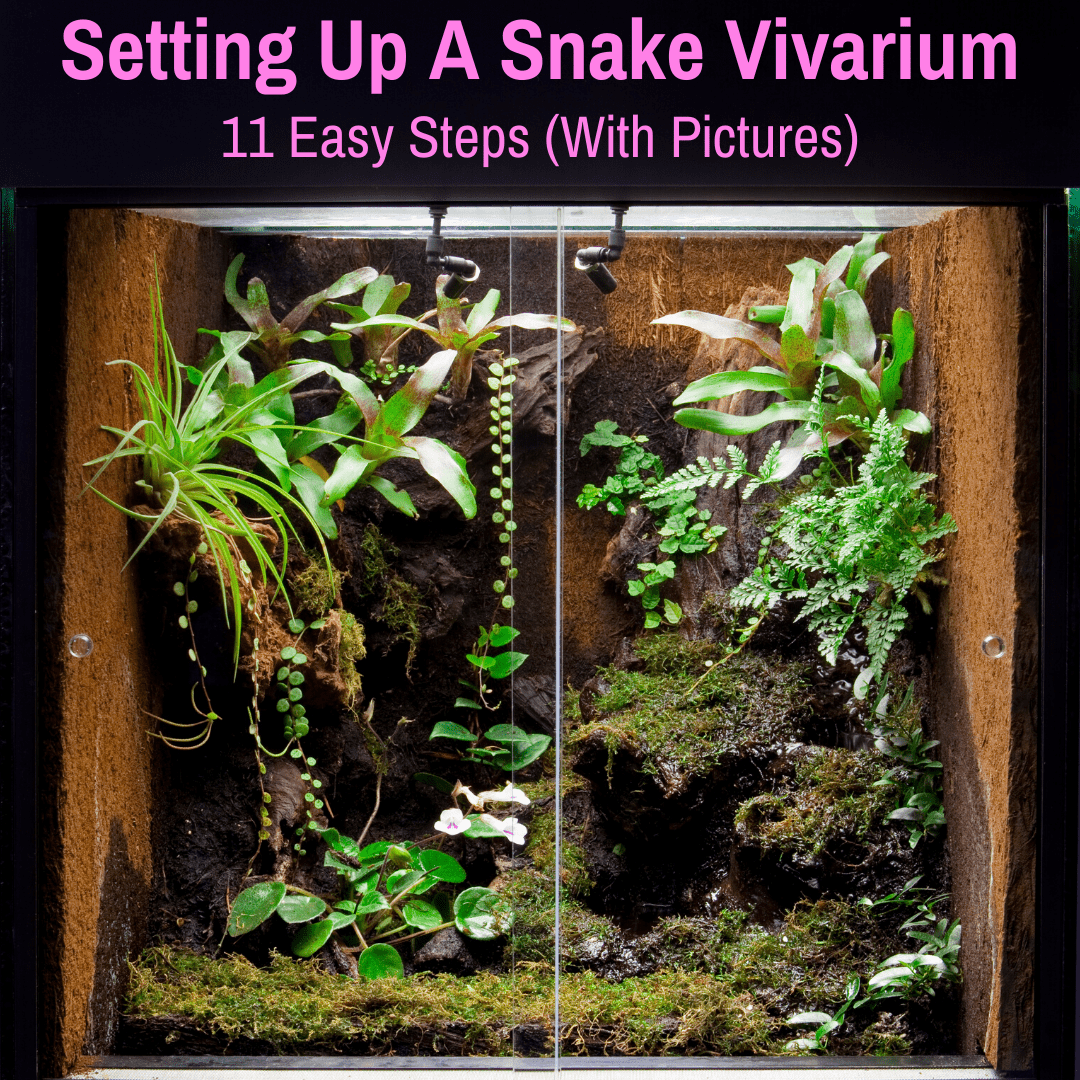
Before you go out and get it, you need a place for it to stay. And no, you can go ahead and put the shoe box away.
You need a real snake vivarium. What exactly is a snake vivarium, you ask?
It’s basically just the habitat you provide the snake inside its enclosure.
Setting up a snake vivarium is not complicated or difficult. It’s mainly a matter of knowing what needs to go inside.
You need to know what all goes into it and how to put it all together to make your snake feel comfortable and happy in its new home.
In this article, we will cover everything you need to know to build the perfect snake vivarium.
Table of Contents
Snake Vivarium
A vivarium is the natural habitat of the snake. You usually build it into the enclosure. You want to make the vivarium as close as possible to the natural environment of the snake.
As a result, it will differ from snake to snake, since it depends on what the natural habitat is for your particular species. It is very important to make your snake as comfortable as possible.
You cannot put it into an empty enclosure and expect it to be happy. You need to build a habitat that will remind your pet snake of home and keep it happy.
What Do You Need To Make A Vivarium?
You will need the following items, I have added a link to an article on our site covering each of the products, or directly to the products on Amazon, if we do not have a specific article. You may also be able to find most, or all, of them in your local pet store.
- Snake enclosure
- Cork bark
- Spider wood type of snake branch
- Gorilla Glue
- Eco Earth
- Pothos
- Fine grain sand
- Lighting hood
- Snake hide
- Water dish
- Heat pad and thermostat
The Enclosure
A vertical enclosure is great for snakes that love spending time in branches, but for most species, we recommend a horizontal one. The most important thing is that it is large enough for your snake (give it plenty of room) and that it is secure (snakes are notorious escape artists). This article will help you find the right enclosure.
Cork Bark
This type of bark is great, because it does not mold. This type of decoration is perfect, because it makes the enclosure look almost like home to the snake.
Spider Wood
This type of wood is ideal, because it makes the vivarium look and feel like home and it does not mold. The last thing you want is gross mold all over your vivarium. It can also pose a danger to your pet.
Gorilla Glue
We will need a lot of this type of glue. It is best to purchase 2 just in case you run out.
Eco Earth
Eco Earth will be the substrate you use. The one we linked to has 3 bricks. They do expand a lot when water is added. You will probably only need to use 2 of these, but buying a pack of 3 is usually cheaper than buying 2 individual packs. Besides, you will eventually use the third one anyway, since you have to replace the substrate once a month.
Pothos
Pothos is a very hardy plant. It will be fine, even if the enclosure gets too wet or too dry. Of course, you can choose whatever plant you want. Just make sure you do not get something that is poisonous or something that dies easily.
Sand
The sand is for mixing with the Eco Earth, in order to add a bit of extra density.
Lighting Hood
You will need a lighting hood to hold a light bulb for your snake. Fluorescent light bulbs are inexpensive and generally work well. The hood will ensures that the light stays outside the enclosure and does not burn the snake.
We prefer a double hood, because it allows you to also use a UV bulb at the same time, or to use a light bulb and a heat bulb concurrently.
Snake Hide
You will also need 2 snake hides, so that your snake can hide away from everything. This makes them feel secure and they do not feel comfortable without it. The reason you want two is so that you can put one hide in the cool spot and the other in the warmer spot of the enclosure.
Water Bowl
You need to keep a water bowl in the enclosure. Not only do snakes need to drink, but they also like to bathe themselves.
Snake Heater And Thermostat
Each species is different, so please do thorough research on the heat requirements of your snake. This is very important, because the wrong temperature can harm your snake and could even kill it. Temperature is one of the most important aspects to get right.
Setting Up The Snake Vivarium
Snake vivariums are so cool if you can get them right. You will also have a much happier snake.
Step One
The Eco Earth expands very quickly once you add it to water. Take out the first block. Add some water to a bucket and put the block in the water and watch it expand.

Step Two
Take your enclosure and lay it on its back. Open the front door and remove the back picture most brands put in the tank. Even if it looks nice, you don’t want to use the backdrop picture, because it will get moldy and wrinkle up. If you do want to use it, take it out and affix it to the outside of the enclosure, not the inside.
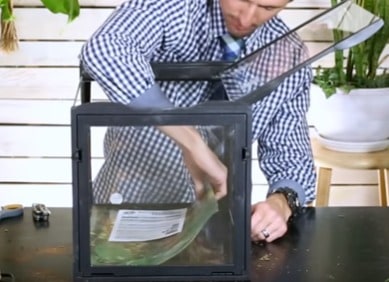
Step Three
Make sure the Eco Earth has been loosened enough in the bucket. Mix it up with your hands.
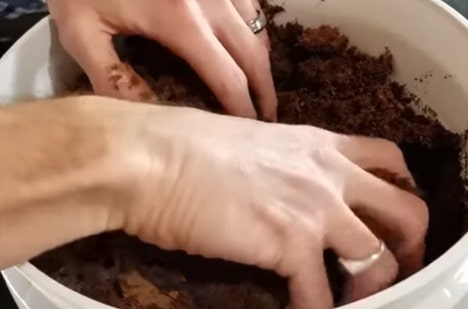
After the Eco Earth has been mixed you can add some of the sand to the mixture and mix everything well. Add as much as you want. There is no best amount to add. The sand adds a bit of density to the Eco Earth. Now mix the mixture all together.
Step Four
After you have mixed up the sand and Eco Earth, it is time to grab your Gorilla Glue. Gorilla glue is activated by water, so start by spraying water on the back of the enclosure. Get the whole back of the enclosure wet.
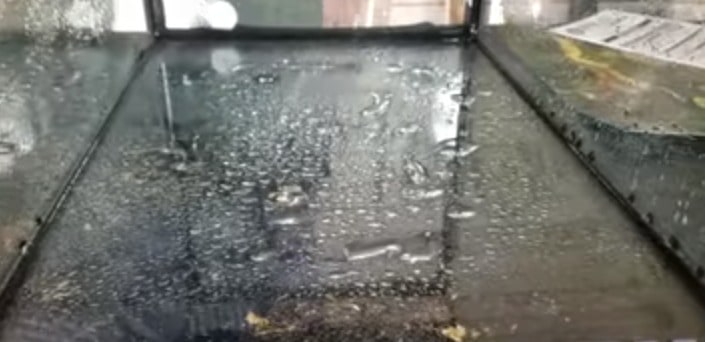
Once you have wet the back of the enclosure you will need to add the Gorilla Glue. Gorilla Glue expands once it touches the water. It is almost like expanding foam.
Add the gorilla glue to the back in a tick tack toe pattern. You only want to add enough to cover the back. Do not leave any holes as this will leave a hole in the backdrop.
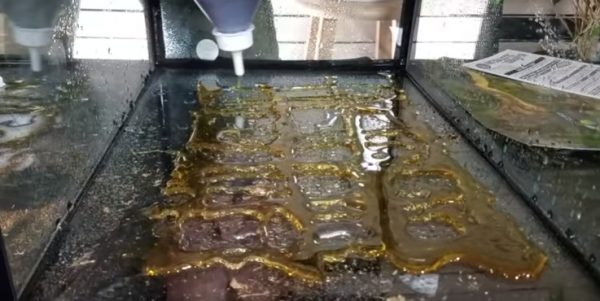
Now go over the holes again making sure that you do not leave any large holes. Do not stress too much about the smaller holes.
Step Five
Take the cork bark and put in the middle of the back of the enclosure. If you have more than one, add as many as you want.
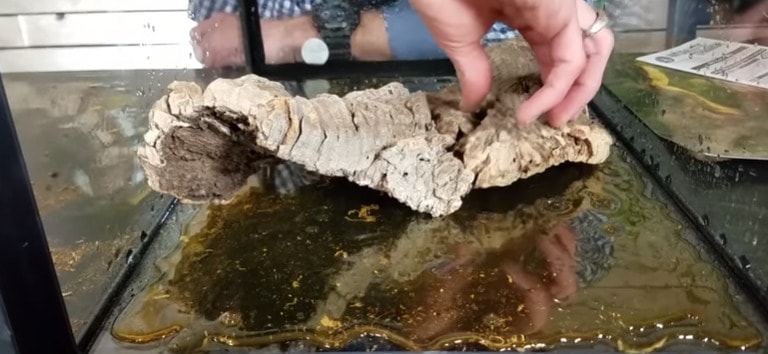
Make sure you add them exactly where you want them. Once the glue dries you will not be able to move them.
Step Six
Grab your spider stick and push it into the glue. Use a rock or something similar outside to hold it up. Make sure the stick is up with the rock or brick or etc. holding it up.
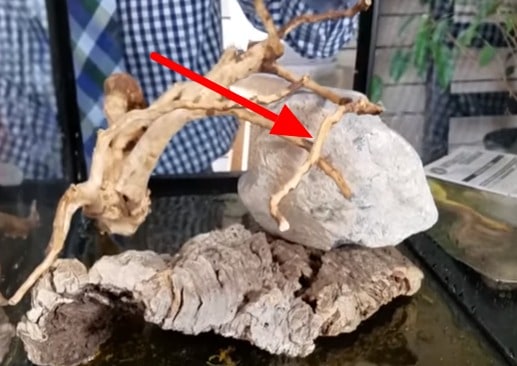
Once again, make sure you are happy with the location of everything. Once the glue dries there is no going back.
Step Seven
Spray some water onto the Gorilla Glue. This will activate the glue. Once the glue is activated it will start expanding. Now add the Eco Earth as in the picture below. Make sure to add it quickly while the glue is expanding. Cover all of the glue with the mixture. Do not leave any glue spots open.
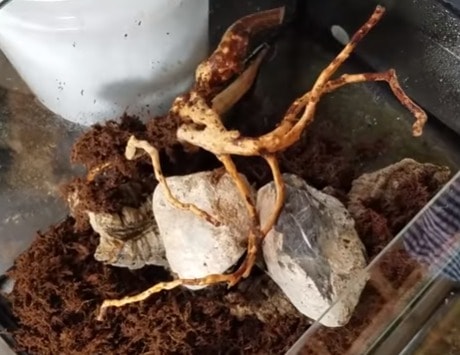
Step Eight
Push the mixture down with your hands as it expands up.
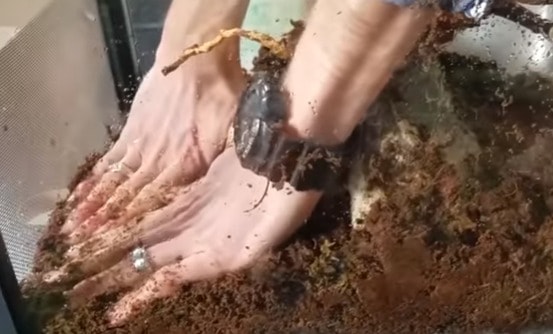
You will notice that the gorilla glue will start expanding every few minutes. If you do not push it back, it will keep expanding and will take up a lot of space in the enclosure.
After about one hour the glue should stop expanding. Leave it overnight and do not stand it up yet.
Once it has dried overnight, you can then take out the rock.
Step Nine
Now you can stand the enclosure up and scrape the substrate onto the ground of the enclosure. Do not dig into the side of the glued substrate. Only take off the bits that are loose.
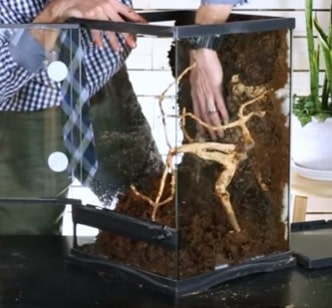
You might notice that some of the glue will stick out. Just pull some of it off so that it blends in.
Step Ten
While some of the substrate from the side has dropped to the bottom, it’s not enough. You’ll need to add more to the bottom from the original mixture that you made. Put enough substrate that it fills the bottom up to the lip of the door.

Take a spray bottle and spray the side substrate so that it drops to the bottom of the tank.
Step Eleven
Take your Pothos out of the holder. You will notice that there are a lot of different plants shooting from many different roots. This is good because you can plant them in various spots around your tank. But make sure you leave spots for the snake hides.
Try to break the plant up as much as possible. Take some of the smaller plants and plant them into the cork bark. This way some of them will grow from the side, which makes the tank feel more natural.
Now you just need to add your light fixture to the top of the enclosure. And don’t forget to add the hides and water bowl!
Pros And Cons Of A Vivarium
Pros
- A vivarium looks great.
- A snake vivarium is very easy to set up. If you follow the steps above, you’ll have yours ready to go in no time.
- The snake will be much happier in a snake vivarium than in a normal enclosure. This is because the vivarium is closer to the snake’s natural habitat. Leaving a snake in a normal enclosure with a few natural features might make the snake feel uncomfortable.
Cons
- The items you add to the enclosure might begin to mold, especially if you have a snake that needs high humidity.
Do Bioactive Vivariums Smell?
As long as you clean up after your snake there will not be any smell. The only thing that will smell is the snake poop. Just simply making sure you clean up every day or so will do this issue out. Also, make sure to clean out any water left in the tank.
Snake Vivarium: Final Thoughts
Now you know how to set up your own snake vivarium. Pretty easy, right?
The key is really just to do the research beforehand and find out exactly what kind of habitat your species of snake likes. Then set up its vivarium to mimic that habitat as closely as possible.
Leave a Reply